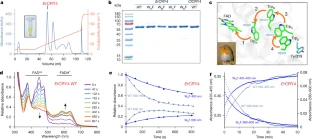Science Daily July 27, 2021
Working under a project co-supported by the US Army, an international team of researchers (Germany, UK, USA – Purdue University, UT Dallas, China) has demonstrated that cryptochrome 4, a protein in birds’ retinas is sensitive to magnetic fields. They identified the molecular mechanism underlying this sensitivity. They extracted the genetic code for cryptochrome 4 and produced the photoactive protein in large quantities using bacterial cell cultures. They used a wide range of magnetic resonance and novel optical spectroscopy techniques to demonstrate its pronounced sensitivity to magnetic fields due to electron transfer reactions triggered by absorption of blue light. They believe that these highly specialized chemical reactions give the birds information about the direction of the Earth’s magnetic field, which acts like a magnetic compass. This fundamental knowledge is critical for informing future technology development efforts aimed at exploiting this mechanism for highly sensitive magnetic field sensors that could enable Army navigation where GPS is unavailable, compromised or denied…read more. TECHNICAL ARTICLE

lPurification, electron transfer pathway and photoreduction of European robin CRY4. Credit: Nature volume 594, pages535–540 (2021)